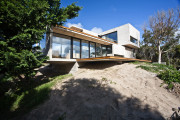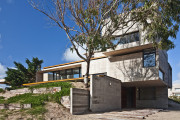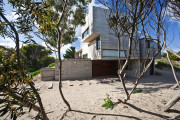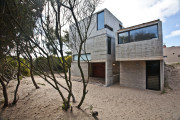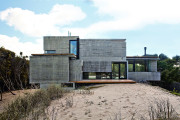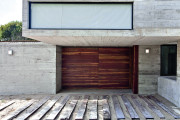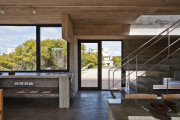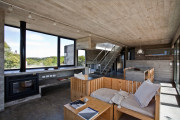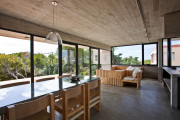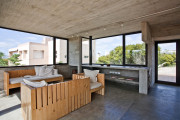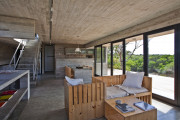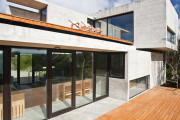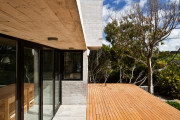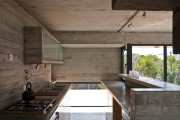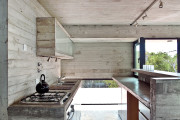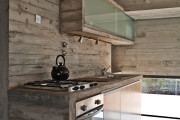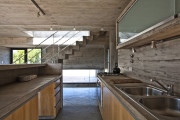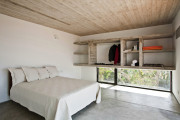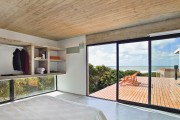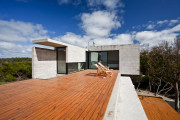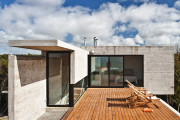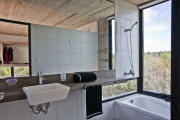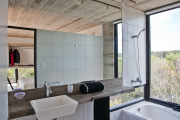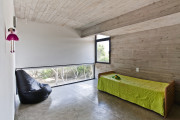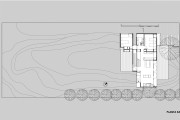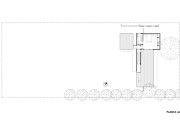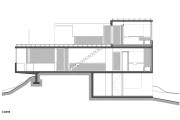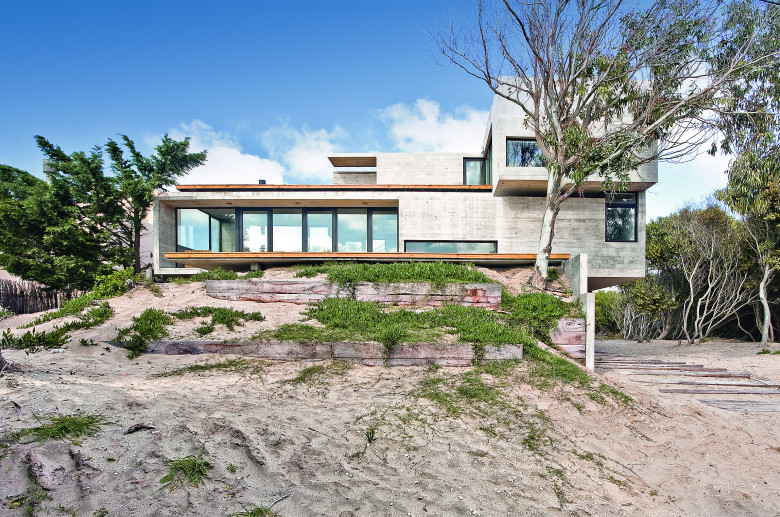House on the Beach
Location: Mar Azul, Buenos Aires Province, Argentina Project Design: María Victoria Besonias, Guillermo de Almeida, Luciano Kruk Collaborators: Arq. Leandro Pomies Land Area: 950sqm Built Area: 181sqm Construction year: 2009 Photos: Guilherme MorelliFirst Prize – Biennale of Architecture, Urbanism, Investigation and Theory 2009
BUILDING ON THE BEACH
Our first work of concrete in Mar Azul was well received and, after several commissions of houses with the same materiality always located in the forest, comes to us this request of a new house also of concrete but just meters from the beach. We doubt, at first, of the validity of using the same constructive-aesthetic system that had arisen so connected to the environment that gave origin to it, but eventually we agreed that we could study the necessary adjustments to make possible its use in a quite different environment: the dunes at the end of the beach. It was essential to optimize the thermal insulation in a place exposed to the intensity of sunlight in summer and, in winter, to a cold wet and strong gust of wind and rain. The action to enable adaptation was to propose a house where the ceilings were expansions of different rooms, made with wooden decks supported on slabs so, while allowing the development of different outdoor activities, play the role of “umbrella” that protects from sunlight (as the forest does on the other houses). We also had to control from the proposal, the glare effect that these rays produce when reflected in the sand. We decided that it wasn’t appropriate to make openings from floor to ceiling and that they should be protected by eaves as well as having control over their size and position in relation to the sun and sweeping winds. With these fundamental premises, we started the project of House on the Beach.
MEMORY
María Victoria Besonías
The Place
The land of 20mx47m where we have to intervene is placed a few meters away of the dune where the beach ends. In spite of it, the land is near a house of big size which clogs in some parts the views to the sea. The rest of the views, free of near buildings, allows the enjoyment of small vegetation, acacias and tamarinds, that overlooks the sea on one side and the forest insinuates on the other. The land has the particularity to present, in the center and along its length, a 3 meters crest elevation in relation to their sides. This singularity and the need to elevate the building over the natural line of the lot to gain sea views were fundamental issues in the proposal.
The commission
The clients, a young couple with 3 little children, arrived to our study asking for a house of concrete -as it seems to has a low maintenance and we love the design of the others houses you have already made – they said – we need a big house with five or six bedrooms and large spaces of meeting but to be realized in two stages – they add. We suggest that, as the existing regulations allows it they can consider building two different housing units, one of them the principal house in a size that allows us to built it in one stage and then another for guests. Satisfied with this proposal and with the aesthetic and constructive solution that the studio had already done in the forest, the clients only conditioned the project requiring us that we should take advantage out of this location so close to the beach to enjoy the sea views from the main rooms of the house, as well as from its expansions.
The program
The commission for the first stage was a house with a main bedroom with bathroom en suite, two bedrooms to the sons with a shared bathroom and a service bedroom for guests, with its own bathroom. It was also required a dining room with integrated kitchen, grill and expansion terrace, a semi-covered garage and an enclosed place to be used as a general deposit and for saving the quadricycle.
The proposal
We focus our search for solutions trying to accommodate this program to this topography and particular environment, looking for gaining views to the sea without making significant changes to the dune. In relation with the path of the sun and the dominant winds, the house must be open to the NE and control its openings to the SO. The lateral facade to the SE, despite of been exposed to strong rains and winds, should have big openings to provide views to the sea. With this premises and working in the transversal section of the land, we note that if we put the principal floor plan of the house like a prism perpendicularly over the crest of the dune, we reach, in one end, views to the sea, while in the other end and under it, we can create an access plan at the same level of the street; and in the same place but over the principal prism we could create another floor which can be the main bedroom and its bathroom with a big terrace providing generous views to the whole land. Decided that the stairway, which logically organizes the three levels, was transformed into a leading place, hence its strategic location and its studied spatial treatment with an emphasis on light entrance and the views generated in its path.
The proposed afforestation, following the principle of minimum intervention in the landscape consisted of projecting retaining walls of quebracho sleepers to help contain the dune to allow the regrowth of the zone’s pastures.
The functional organization
After saving the difference of height between the street and the access level with the help of wood planks, it is accessed to the house by a semi-covered (which can be used as a garage) where a quebracho tables’ wall is highlighted formed by the gateway that closes the storage and also the entrance door. In this level it is placed a small hall, the guest room with its bathroom and the internal entry to the storage and the laundry. Going up the stairs between concrete walls you get to the main floor of the house. It has a living room with integrated kitchen, with expansions to the front and the back of the lot, and two bedrooms for the children with a bathroom for this level. In parallel to the first staircase develops the stairs leading to the top floor of the house. By this one, you reach a small hall from which you can access a large terrace to the front and one to the back, and also the main bedroom with bathroom en suite. This room has outstanding views towards the beach and through a generous opening can go out to the main terrace from which one can enjoy views of the whole landscape.
The structural solution
The entire house is solved by reinforced concrete partitions and slabs. The versatility of this constructive system allows us to solve the important overhang of the semi-covered access as it doesn’t have any support in one of its extremes, as we consider relevant for the project that the three levels of the house were not expressed in the front. We also use a significant cantilever on the opposite end, where the dune falls abruptly, so that the house lean without altering its natural profile.
The construction
It was used the same concrete of the other works in Mar Azul (H21 with fluidizer) a mixture with low amount of water that when forge create a concrete with a lot of compactness. As a result of this process, it is not necessary to employ any kind of facing, achieving a low budget in its terminations and a minimum or non posterior maintenance. The adaptation of the constructive system used in the forest for this place, consist in the use of “decks as umbrellas”. They are made by braces of wood seated to the slab on which the tables rely so that between them and the concrete ceiling is a space through which air flows. On the other hand , to improve the thermal insulation of the exterior walls it was build, in the interior part, a wall of air bricks revoked and painted, and also it was thought, in the whole locals, cross ventilation to make the maritime winds cool in the days of high temperature and to avoid using air conditioning system. The openings are made by aluminum; it was used open windows instead of sliding windows in order to avoid the accumulation of sand in the guides, and it was used double glass with air chamber to optimize the thermal insulation. The heating system, because of the fact that there is not natural gas in the zone, was resolved with a system that agreed salamander, bottle gas stove and electrical resistances.
The whole interior septums are made by air-bricks revoked and painted with white latex. The bathrooms have ceramic facings in the walls which are not made by reinforced concrete. The floor is made by smooth cement divided by aluminum’s planks. The encounter between walls and floor was resolved with an aluminum profile as a socle.
Furniture
It was design by the study; it is an agreed between immobile furniture made of concrete and mobile furniture made of recovered Canadian wood pine which comes from boxes of package’s engines. The table (resolved like a slab united to the septum which divides the kitchen and the living room), the closets, and the woodshed are made of concrete.
House on the Beach
Location: Mar Azul, Buenos Aires Province, Argentina Project Design: María Victoria Besonias, Guillermo de Almeida, Luciano Kruk Collaborators: Arq. Leandro Pomies Land Area: 950sqm Built Area: 181sqm Construction year: 2009 Photos: Guilherme MorelliFirst Prize – Biennale of Architecture, Urbanism, Investigation and Theory 2009
BUILDING ON THE BEACH
Our first work of concrete in Mar Azul was well received and, after several commissions of houses with the same materiality always located in the forest, comes to us this request of a new house also of concrete but just meters from the beach. We doubt, at first, of the validity of using the same constructive-aesthetic system that had arisen so connected to the environment that gave origin to it, but eventually we agreed that we could study the necessary adjustments to make possible its use in a quite different environment: the dunes at the end of the beach. It was essential to optimize the thermal insulation in a place exposed to the intensity of sunlight in summer and, in winter, to a cold wet and strong gust of wind and rain. The action to enable adaptation was to propose a house where the ceilings were expansions of different rooms, made with wooden decks supported on slabs so, while allowing the development of different outdoor activities, play the role of “umbrella” that protects from sunlight (as the forest does on the other houses). We also had to control from the proposal, the glare effect that these rays produce when reflected in the sand. We decided that it wasn’t appropriate to make openings from floor to ceiling and that they should be protected by eaves as well as having control over their size and position in relation to the sun and sweeping winds. With these fundamental premises, we started the project of House on the Beach.
MEMORY
María Victoria Besonías
The Place
The land of 20mx47m where we have to intervene is placed a few meters away of the dune where the beach ends. In spite of it, the land is near a house of big size which clogs in some parts the views to the sea. The rest of the views, free of near buildings, allows the enjoyment of small vegetation, acacias and tamarinds, that overlooks the sea on one side and the forest insinuates on the other. The land has the particularity to present, in the center and along its length, a 3 meters crest elevation in relation to their sides. This singularity and the need to elevate the building over the natural line of the lot to gain sea views were fundamental issues in the proposal.
The commission
The clients, a young couple with 3 little children, arrived to our study asking for a house of concrete -as it seems to has a low maintenance and we love the design of the others houses you have already made – they said – we need a big house with five or six bedrooms and large spaces of meeting but to be realized in two stages – they add. We suggest that, as the existing regulations allows it they can consider building two different housing units, one of them the principal house in a size that allows us to built it in one stage and then another for guests. Satisfied with this proposal and with the aesthetic and constructive solution that the studio had already done in the forest, the clients only conditioned the project requiring us that we should take advantage out of this location so close to the beach to enjoy the sea views from the main rooms of the house, as well as from its expansions.
The program
The commission for the first stage was a house with a main bedroom with bathroom en suite, two bedrooms to the sons with a shared bathroom and a service bedroom for guests, with its own bathroom. It was also required a dining room with integrated kitchen, grill and expansion terrace, a semi-covered garage and an enclosed place to be used as a general deposit and for saving the quadricycle.
The proposal
We focus our search for solutions trying to accommodate this program to this topography and particular environment, looking for gaining views to the sea without making significant changes to the dune. In relation with the path of the sun and the dominant winds, the house must be open to the NE and control its openings to the SO. The lateral facade to the SE, despite of been exposed to strong rains and winds, should have big openings to provide views to the sea. With this premises and working in the transversal section of the land, we note that if we put the principal floor plan of the house like a prism perpendicularly over the crest of the dune, we reach, in one end, views to the sea, while in the other end and under it, we can create an access plan at the same level of the street; and in the same place but over the principal prism we could create another floor which can be the main bedroom and its bathroom with a big terrace providing generous views to the whole land. Decided that the stairway, which logically organizes the three levels, was transformed into a leading place, hence its strategic location and its studied spatial treatment with an emphasis on light entrance and the views generated in its path.
The proposed afforestation, following the principle of minimum intervention in the landscape consisted of projecting retaining walls of quebracho sleepers to help contain the dune to allow the regrowth of the zone’s pastures.
The functional organization
After saving the difference of height between the street and the access level with the help of wood planks, it is accessed to the house by a semi-covered (which can be used as a garage) where a quebracho tables’ wall is highlighted formed by the gateway that closes the storage and also the entrance door. In this level it is placed a small hall, the guest room with its bathroom and the internal entry to the storage and the laundry. Going up the stairs between concrete walls you get to the main floor of the house. It has a living room with integrated kitchen, with expansions to the front and the back of the lot, and two bedrooms for the children with a bathroom for this level. In parallel to the first staircase develops the stairs leading to the top floor of the house. By this one, you reach a small hall from which you can access a large terrace to the front and one to the back, and also the main bedroom with bathroom en suite. This room has outstanding views towards the beach and through a generous opening can go out to the main terrace from which one can enjoy views of the whole landscape.
The structural solution
The entire house is solved by reinforced concrete partitions and slabs. The versatility of this constructive system allows us to solve the important overhang of the semi-covered access as it doesn’t have any support in one of its extremes, as we consider relevant for the project that the three levels of the house were not expressed in the front. We also use a significant cantilever on the opposite end, where the dune falls abruptly, so that the house lean without altering its natural profile.
The construction
It was used the same concrete of the other works in Mar Azul (H21 with fluidizer) a mixture with low amount of water that when forge create a concrete with a lot of compactness. As a result of this process, it is not necessary to employ any kind of facing, achieving a low budget in its terminations and a minimum or non posterior maintenance. The adaptation of the constructive system used in the forest for this place, consist in the use of “decks as umbrellas”. They are made by braces of wood seated to the slab on which the tables rely so that between them and the concrete ceiling is a space through which air flows. On the other hand , to improve the thermal insulation of the exterior walls it was build, in the interior part, a wall of air bricks revoked and painted, and also it was thought, in the whole locals, cross ventilation to make the maritime winds cool in the days of high temperature and to avoid using air conditioning system. The openings are made by aluminum; it was used open windows instead of sliding windows in order to avoid the accumulation of sand in the guides, and it was used double glass with air chamber to optimize the thermal insulation. The heating system, because of the fact that there is not natural gas in the zone, was resolved with a system that agreed salamander, bottle gas stove and electrical resistances.
The whole interior septums are made by air-bricks revoked and painted with white latex. The bathrooms have ceramic facings in the walls which are not made by reinforced concrete. The floor is made by smooth cement divided by aluminum’s planks. The encounter between walls and floor was resolved with an aluminum profile as a socle.
Furniture
It was design by the study; it is an agreed between immobile furniture made of concrete and mobile furniture made of recovered Canadian wood pine which comes from boxes of package’s engines. The table (resolved like a slab united to the septum which divides the kitchen and the living room), the closets, and the woodshed are made of concrete.

